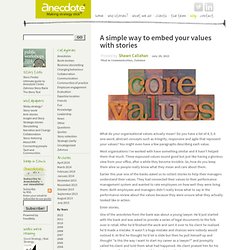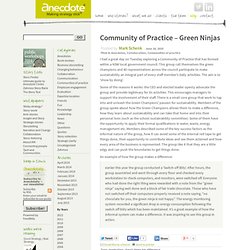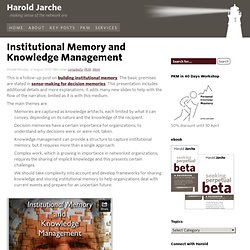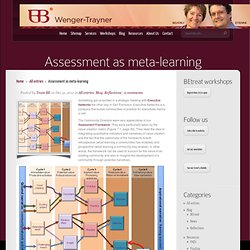

Personalized Professional Learning Plans. Rubrics. Teacher Effectiveness. Leading communities and networks - CoP Evaluation. Wp-content/uploads/2011/12/11-04-Wenger_Trayner_DeLaat_Value_creation.pdf. Storytelling. Telling a Story. A simple way to embed your values with stories. Posted by Shawn Callahan - July 29, 2013Filed in Communication, Zahmoo What do your organisational values actually mean?

Do you have a list of 4, 5, 6 one-word, abstract concepts such as integrity, responsive and agile that represent your values? You might even have a few paragraphs describing each value. Most organisations I’ve worked with have something similar and it hasn’t helped them that much. These espoused values sound good but just like having a glorious view from your office, after a while they become invisible. Earlier this year one of the banks asked us to collect stories to help their managers understand their values. Enter stories. One of the anecdotes from the bank was about a young lawyer. For the bank this is what integrity can look like. But one example is not enough. In fact you need to create a systematic way to not only share the stories across the company but help people talk about what the story actually means to them.
Comments Off. Munity of Practice - Green Ninjas. Posted by Mark Schenk - June 24, 2010Filed in Anecdotes, Collaboration, Communities of practice I had a great day on Tuesday exploring a Community of Practice that has formed within a NSW local government council.

This group call themselves the green champions and 40 representatives across the council participate to make sustainability an integral part of every staff member’s daily activities. The aim is to ‘show by doing’. Some of the reasons it works: the CEO and elected leader openly advocate the group and provide legitimacy for its activities. This encourages managers to support the involvement of their staff.
The Story Test. Institutional Memory and Knowledge Management. This is a follow-up post on building institutional memory.

The basic premises are stated in sense-making for decision memories. This presentation includes additional details and more explanations. It adds many new slides to help with the flow of the narrative, limited as it is with this medium. The main themes are: Memories are captured as knowledge artifacts, each limited by what it can convey, depending on its nature and the knowledge of the recipient. Decision memories have a certain importance for organizations; to understand why decisions were, or were not, taken. Knowledge management can provide a structure to capture institutional memory, but it requires more than a single approach. Assessment as meta-learning. Something got us excited in a strategic meeting with Executive Networks the other day in San Francisco.

Executive Networks is a company that builds communities of practice for executives mainly in HR. The Community Directors were very appreciative of our Assessment Framework. They were particularly taken by the value-creation matrix (Figure 7.1, page 39). Purposes and Goals of Community Evaluation. PART 1: Collection of resources on M&E and development of coalitions, networks and Communities of Practice. Resources and Tools for Evaluation of Online Communities of Practice. Steinhardt.nyu.edu/scmsAdmin/uploads/004/299/fulltext.pdf. Evaluation framework. As communities and networks go more mainstream there is an increasing demand from organizations to have ways of monitoring their value.

How can we make the connection between the activities of a community or network and the improved performance of an organization, institution or even a country? In our value assessment framework, published by the Open University of the Netherlands, we identify five levels of value creation of a community or network: Cycle 1.
Immediate value: the activities and interactions between members have value in and of themselvesCycle 2. Potential value: the activities and interactions of cycle 1 may not be realized immediately, but rather be saved up as knowledge capital whose value is in its potential to be realized later.Cycle 3. For a reliable picture of how the community is creating value we would have to follow the value creation across these different cycles. Contents Download You can download the full text in PDF format here: Download the evaluation framework. Wp-content/uploads/2011/07/707_COCP-Evaluation-Brief-July_2011.pdf.
Resources and Tools for Evaluation of Online Communities of Practice. ISTE 2013. Purpose & Objectives As social networking technologies are increasingly being leveraged by educators to share resources and advice; deepen pedagogical and content knowledge; debate pedagogy and policy; and broaden perspectives, researchers and practitioners alike want to better understand the power and potential of different online social learning spaces (Baker-Doyle & Yoon, 2010; Booth, 2013; Duncan-Howell, 2010; Farooq, Schank, Harris, Fusco, & Schlager, 2007; Hur & Brush, 2009; Nussbaum-Beach & Hall, 2012, Vavasseur & MacGregor, 2008; Wenger, White, & Smith, 2009).

The increasing importance of online communities for educators is emphasized in the United States’ 2010 National Education Technology Plan (U.S. Outline Supporting Research Baker-Doyle, K., & Yoon, S. Presenter Background Sherry Booth, Ph.D. is a Research Associate at the Friday Institute for Educational Innovation at North Carolina State University. ISTE 2013. Spidergram Poster 2013. Redirect Notice. Redirect Notice. Performance improvement & assessment of collaboration: starting poi...